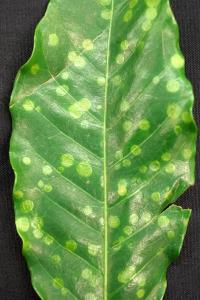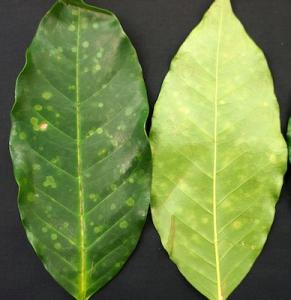Citizen science effort encouraged to track new coffee pest
University of Hawaiʻi at MānoaSpecialist, Plant & Environmental Protection Sciences
Miles Hakoda, (808) 956-3093
Director, Office of Communication Services
A new pest of coffee has been discovered by Drs. Scot Nelson and Michael Melzer, faculty at the UH Mānoa College of Tropical Agriculture and Human Resources (CTAHR). The disease symptoms, which have not been reported anywhere else in the world, are circular yellow or yellow-green lesions, or spots, about ¼” (5 mm) in diameter on the leaves and petioles (stems). Anecdotal evidence suggests that it renders the coffee cherries unusable, though it is not yet known what the lesions look like on the cherries. More pictures of affected leaves can be found at the website Nelson has created to publicize the disease: https://sites.google.com/a/hawaii.edu/emaravirus-infects-coffee-in-Hawaii/
In January 2014, a coffee farmer contacted Nelson via the plant disease diagnosis app he created, The Plant Doctor (http://hawaiiplantdisease.net/%22The-Plant-Doctor%22-app-for-Android-and-iPhones.php), to ask about the spots on his coffee leaves. Nelson had never seen the disease before. Melzer visited the farm with CTAHR extension agent Andrea Kawabata, who has been instrumental in helping farmers to deal with another devastating pest, the coffee berry borer. They found several symptomatic plants in two locations at the farm, and they could also see some symptomatic plants across a fence at a neighboring coffee farm.
According to Melzer’s analysis, a new species of virus similar to emaraviruses was found in the symptomatic coffee. There is no specific evidence that the virus causes this disease, though efforts are under way to investigate this. To date, no emaraviruses have ever been reported to infect coffee. Emaraviruses are transmitted by eriophyid mites, which can be spread on wind currents as well as by the movement of infected plant material.
Much needs to be learned about the pest, including the mite or other vector of the virus; the genetics of the virus itself; whether in fact it is the cause of the disease symptoms; other host plants that it might affect; what the level of threat is to coffee plants, including potential for yield loss; the precise mode of virus transmission or disease epidemiology; and the geographic distribution of the virus. Researchers and extension agents at CTAHR and specialists at the Hawai‘i Department of Agriculture are attempting to resolve those questions now.
Members of the community can help to answer several of these questions, particularly the geographic range. Anyone who sees symptoms of the disease at their farm is asked to contact Scot Nelson at snelson@hawaii.edu or via his Plant Doctor app, which can be downloaded and used for free by iPhone and Android users, or Andrea Kawabata at andreak@hawaii.edu. The HDOA has expressed interest in conducting a survey of farms in the area to determine the spread of the disease, but this will take time, so individuals are encouraged to report on their own crops as soon as possible, in a citizen science effort akin to the recent Pulelehua Project to track the Kamehameha butterfly.
Until more information is available, Nelson and Kawabata can offer only general suggestions for growers who have symptomatic plants. After reporting the plants, growers should isolate them and refrain from transporting cuttings, cherries, leaves or other plant material from them to another site. Sterilize pruning tools that have been used on symptomatic plants with a propane torch or a 10% bleach solution before pruning other plants.
After the disease is confirmed, growers should first control mites, the presumed vector, so that they do not move to new plants. Neem oil, which is available at many farm and garden supply and home improvement stores, as well as online, may be the most effective miticide registered for application to coffee in Hawai‘i. Depending on the method of processing, some forms of neem oil are also approved for use by organic farmers. Other miticides exist, but few are registered as yet for coffee in Hawai‘i, because historically mites have not been a problem on coffee plants here. (http://pesticides.Hawaii.edu/hipmrinn/coffee_licensed_products201208.pdf). After the plants are treated for mites, they can either be destroyed by burning the plants (a permit may be required) or cutting down and bagging the plants in heavy-duty garbage bags (woody parts may be chipped before bagging). The bags should left to sit in the sun for a few days, after which the plants can be composted.
More information will be publicized as it becomes available. “We don’t know yet how much of a problem we are dealing with,” Nelson commented, “but based on Hawai‘i’s experience with other new plant diseases, we need to get started dealing with it as soon as possible.”
For more information, visit: http://www.ctahr.hawaii.edu


